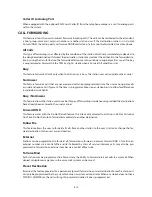
MUSIC ON HOLD—FLEXIBLE
The OfficeServ 7200 allows its music sources to be used in flexible manner as follows:
Each keyset can have a designated music source for playing as Background Music (BGM) through the keyset
speaker.
Each Station can have a designated music source for playing to callers placed on Exclusive hold at that sta-
tion.
Each Trunk can have a designated music source for playing to callers placed on hold. This setting is overrid-
den by some of the other settings such as station music on hold, DID MOH and UCD MOH.
Each UCD group can have a designated music source to be played while a caller is in queue.
Each entry in the DID translation table can have a designated music source to be played when a caller to that
DID number is placed on hold.
MUSIC ON HOLD – SOURCES
The OfficeServ 7200 provides for up to five different types of Music on Hold source including silence or
“NONE” as listed below:
•
None: No audio is played to the listener
•
Tone: A tone or “beep” is repeated at a programmable interval
•
Chime: A music chime source (Old Folks At Home) located on the MCP card is played to the listener.
•
External Source: An external source connected to a MISC card, such as a digital announcer or radio, is
played to the listener.
•
Voicemail Sound File: If the OfficeServ 7200 system has an optional SVMi card installed, up to 100 cus-
tom recorded sound files from the Voice Mail card can be used for MOH sources. For more information
on creating the sound files see SVMi System Administrator Manual-Recording Greeting by Number. If you
select this option be advised that each VMMOH source requires a dedicated SVMi port.
NETWORKING
The OfficeServ 7200 system allows up to 15 systems to be networked together with a high level of feature
integration. The networked systems may be any combination of iDCS 100R2, iDCS 500R2, and OfficeServ
7200 systems running V2.46 or higher software. The physical connection between systems can be an IP net-
work or proprietary PRI connection using Samsung’s proprietary version of QSIG, called SPNet. If PRI connec-
tion is used, the maximum number of nodes may be limited by the maximum number of TEPRI cards that can
be installed.
When engineering the network of systems, a discrete numbering plan must be used. The size and complexi-
ty of the numbering plan as well as the number of stations and trunks may limit the actual number of nodes
available to the network.
•
Auto Answer Across Network: This setting will allow station to station calls across the network to follow
the auto answer setting of the called keyset.
•
Call Completion, Busy Station (CCBS) also known as Callback or Busy Station Callback. When a station in
one system calls a station in another system across the network link and the destination station is busy
the calling station can set a Callback to the busy station. When the busy station becomes idle the system
will notify the callback originating station by ringing that station and when the originating station
answers, the system will call the destination station.
Not available on QSIG over PRI.
4.20
















































